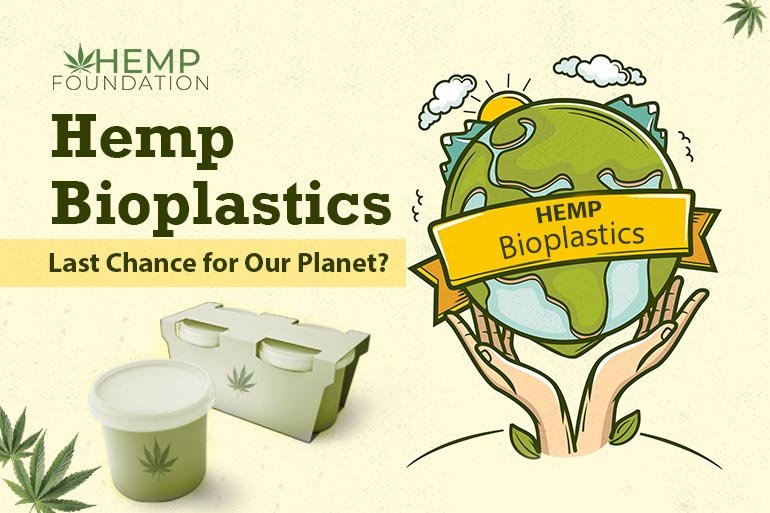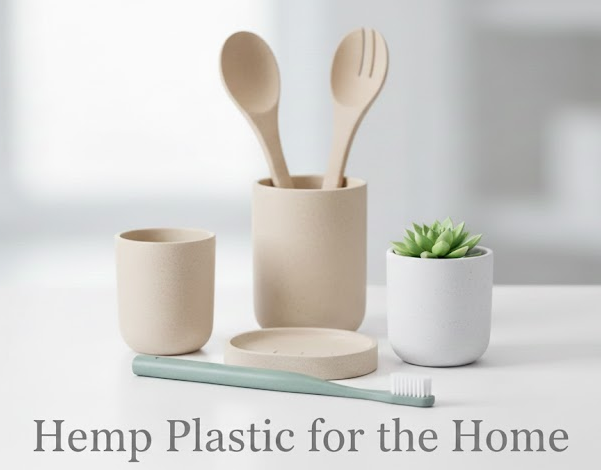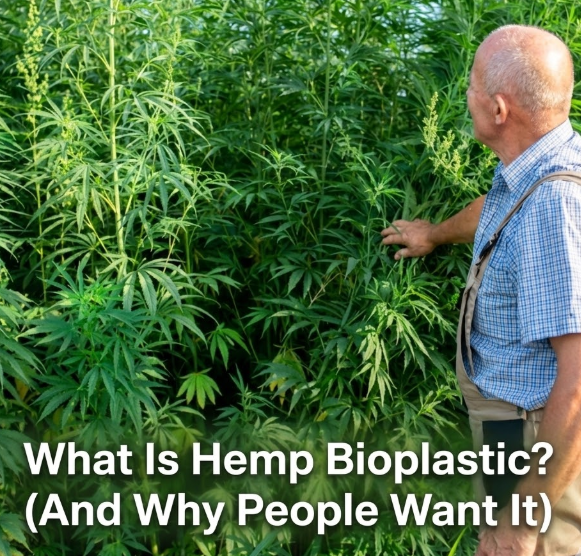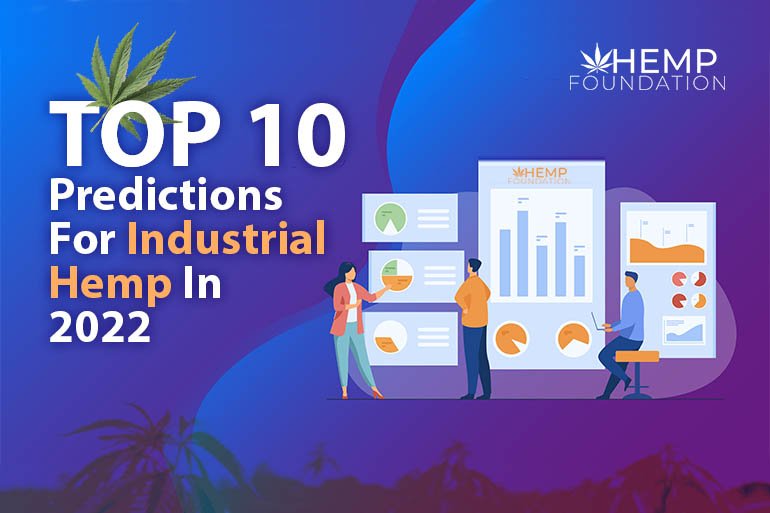Hemp Bioplastics – Last Chance for Our Planet?
[vc_row full_width=”stretch_row_content_no_spaces” background_color=”custom” custom_background_color=”#568243″][vc_column][vc_row_inner lg_spacing=”padding_top:40;padding_left:105″][vc_column_inner][vc_column_text]
Hemp Bioplastics – Last Chance for Our Planet?
[/vc_column_text][vc_column_text css=”.vc_custom_1643257581280{padding-right: 70px !important;}”]
The world is focused on climate change. No wonders why.
- Global temperatures have risen by 1 C in the past century.
- The year 2020 was scorching, with an average temperature of 0.98 C higher than the 20th-century average
- Seven warmest years on record have occurred since 2014
We are headed towards a catastrophe.
Unfortunately, those facts, sobering as they are, tend to push into the background a more immediate problem – the menace of plastics.
The world is literally drowning in plastic waste. Landfills are overflowing with discarded bottles, shrink wraps, and empty containers of every size and shape. In South Africa, plastic bags flapping in the wind are so ubiquitous that they have been dubbed as “national flower”.
It’s not a disaster in the making, but a disaster that is happening.
How can we overcome our reliance on plastic and shift to more sustainable materials? At Hemp Foundation, we choose to obsess over this question. And we’re close to finding the answer. The answer is hemp bioplastic.
[/vc_column_text][/vc_column_inner][/vc_row_inner][/vc_column][/vc_row][vc_row full_width=”stretch_row_content_no_spaces” background_color=”custom” custom_background_color=”#f9f6f0″][vc_column][tm_spacer size=”lg:40″][vc_row_inner lg_spacing=”padding_left:80″][vc_column_inner][vc_column_text css=”.vc_custom_1640768082787{padding-right: 70px !important;}”]Expect answers to these questions in the next 15-20 minutes of your reading time:
- Why is the industry addicted to plastic?
- How did we get from pre-plastic days to these days of plastic’s omnipresence?
- What is bioplastic? A fancy term, or something credible?
- What’s hemp? How do we grow it? How do we get hemp bioplastic from it?
- Why is bioplastic a potent, safe, and sustainable alternative to plastic?
- Why is plastic pollution graver than you think?
- What does our hemp bioplastic product catalog look like? (Yes, we’d love for you to try some; more importantly, we wish to demonstrate what we can do with bioplastics.)
[/vc_column_text][/vc_column_inner][/vc_row_inner][/vc_column][/vc_row][vc_row full_width=”stretch_row” background_color=”custom” lg_spacing=”padding_top:50;padding_bottom:50″ custom_background_color=”#ffffff”][vc_column][vc_column_text]
The Triumph of Plastics – a Brief Timeline
[/vc_column_text][vc_row_inner lg_spacing=”margin_top:-60″][vc_column_inner lg_spacing=”padding_top:50″][tm_image align=”center” image=”22481″][vc_column_text][/vc_column_text][vc_column_text]
- The first-ever plastic was a material known as Parkesine developed by Alexander Parkes in 1862.
- In 1907, the first commercially successful plastic was invented by Dr. Leo Bakeland and called Bakelite.
- In 1920, the German chemist Hermann Staudinger proved the existence of macromolecules, commonly known as polymers. Plastics are a type of polymer.
- From the mid-1930s, the race for new materials led to the development of several varieties of plastics, including polyethylene, polystyrene, and nylon. The war in 1939 proved to be a catalyst for research.
- After the war polyester was invented, the first synthetic fabric material.
- By the late 1960s, plastics began to replace metal on a large scale. The use of plastics for everyday objects became the norm—bins, buckets, bags. Plastic was adopted by the automobile industry in a big way since it reduced vehicle weight and hence fuel consumption.
- Plastic also became the de facto packaging material with high and low-density polyethylene (HDPE and LDPE) completely replacing paper for wrapping.
[/vc_column_text][/vc_column_inner][/vc_row_inner][vc_row_inner][vc_column_inner][tm_spacer size=”lg:40″][vc_column_text css=”.vc_custom_1640768359532{padding-right: 70px !important;}”]Rapid growth in plastic production began in the 1950s.
- In 1954, only 3 million tons were produced.
- In a decade it had jumped to 15 million tons, a rise of 500%.
- It crossed 100 million tons in 1987. The peak was 381 million tons in 2015 and it has currently scaled back slightly to 367 million tons.
A startling fact that does not get much attention:
From 1950 to the present, 8.3 billion tons have been produced. There are 7.9 billion humans, and thus there is at least a ton of plastic out there for each of us.[/vc_column_text][vc_column_text]
 source : https://ourworldindata.org
source : https://ourworldindata.org
Scary facts about plastic consumption everyone needs to know:
- 2 million plastic bags are used every minute.
- The energy required to make a dozen bags could power a car for a mile.
- Every 60 seconds a truckload of plastic (10 tons) finds its way to the ocean.
- One million plastic bottles are consumed every minute.
That is unnerving and unsustainable. We need to look for better alternatives that contribute to a cleaner, greener lifestyle.
Bioplastics from hemp has emerged as a reasonable solution to this nightmare.[/vc_column_text][/vc_column_inner][/vc_row_inner][/vc_column][/vc_row][vc_row full_width=”stretch_row_content_no_spaces” background_color=”custom” custom_background_color=”#f9f6f0″][vc_column][tm_spacer size=”lg:40″][vc_column_text]
Hemp — A Plant That Can Save the Earth
[/vc_column_text][vc_row_inner lg_spacing=”padding_left:80″][vc_column_inner][vc_column_text css=”.vc_custom_1640855459915{padding-right: 70px !important;}”]Hemp (Cannabis sativa) has been harvested for several thousand years. It originated in Central Asia and there is evidence of it being cultivated in China nearly 5000 years ago.
By the time Christianity spread across Europe, hemp had become an important commercial crop.
Hemp fabric has been around for many centuries. In fact, it was popular till cheap cotton from American plantations dislodged it.
Unfortunately, in the 20th century, there has been a lot of focus on the mind-altering capability of THC or Tetrahydrocannabinol, a chemical agent found in some varieties of hemp. Hemp was associated with cannabis and gradually fell out of use.[/vc_column_text][/vc_column_inner][/vc_row_inner][/vc_column][/vc_row][vc_row full_width=”stretch_row” background_color=”custom” lg_spacing=”padding_top:50;padding_bottom:50″ custom_background_color=”#f9f6f0″][vc_column][vc_row_inner lg_spacing=”padding_right:199;padding_left:200″ md_spacing=”padding_right:20;padding_left:20″ sm_spacing=”padding_right:19;padding_left:20″ xs_spacing=”padding_right:20;padding_left:20″][vc_column_inner][tm_image align=”center” image=”22425″][/vc_column_inner][/vc_row_inner][vc_column_text]Of late hemp has been enjoying a revival.
The 2018 Farm Bill decriminalized the cultivation of industrial hemp (hemp with less than 0.3% THC) in the USA. By the end of 2019, it was legal to grow hemp in 46 US states.
Hemp is useful in more ways than one.
Hemp fabric is a suitable replacement for cotton and polyester.
Polyester is a byproduct of crude oil processing. It does not biodegrade and its production has a large carbon footprint.
Cotton is far from an ideal crop. It is grown on 2.5% of total agricultural land but requires 23% of all pesticides used.
Such widespread use of pesticides leads to contamination of groundwater and diseases from slow poisoning.
Also, cotton needs plenty of water. Over two tons of water is needed to grow enough cotton for a shirt.
Hemp produces natural oils which repel pests. A minimal quantity of pesticide is needed for its cultivation. It requires half the amount of water per acre. Hemp can be planted closer together. Thus, overall water use is a quarter that of cotton.
Hemp seeds are the perfect source of protein and fiber. Hemp contains plenty of Omega fatty acids that are essential for heart health.
Most important of all, industrial hemp is the raw material for hemp plastics.
Hemp plastics or bioplastics, as it is known, can change the wretched narrative of plastic pollution.[/vc_column_text][/vc_column][/vc_row][vc_row][vc_column][vc_row_inner][vc_column_inner][vc_column_text]
Hemp Plastics—a Ray of Light on the Horizon
Polymers can be derived not only from crude oil but also from cellulose.
Cellulose is a polysaccharide (complex carbohydrate) that cannot be digested by humans. It is plentiful in hemp.
Hemp plastic promises to be able to replace several types of plastics used in packaging.
Cellophane from hemp was manufactured as early as 1912.
Ongoing research has been extremely promising and has the potential to be a game-changer.
It is a matter of time before plastics from hydrocarbons are phased out in favor of more eco-friendly products.
Plastic straws are banned in a dozen US states including Colorado, Arizona, Montana, Nevada, and New York.
The UK government has banned several single-use plastic items including straws and cutlery.
The EU put severe restrictions on the use of SUPPs in July 2021.
These legislative measures have helped popularize the use of hemp plastics.
The Indian government has announced a ban on several single-use plastic products from July 2022.
There is no doubt that the ban on SUPPs would spread and cause a spurt in the research by hemp bioplastic manufacturers.
Why Is Plastic Omnipresent?
Before we attempt to change the current scenario for the better, we have to understand why fossil-fuel based plastics are so popular.
It is not easy to convince billions of consumers to change their buying habits. And unless we have a clear idea, we shall not be able to rectify the problem at a fundamental level. We are at a tipping point and superficial fixes won’t suffice.
1. Plastic is inert
Plastic is chemically inert. You can store alcohol, gasoline, chemicals, and food in it without interaction.
So safe is plastic that modern medical procedures largely depend on plastic. The humble syringe to IV cannula, bags (for blood and saline solution), medical gloves, and masks are all made of plastic.
If plastic production stopped, hospital ERs would cease to operate.
2. Plastic is waterproof
Our food comes wrapped in plastic.
Walk into any supermarket from Seoul to Seattle and you will find bread, meat, cucumber, and bananas wrapped in plastic.
Plastic is waterproof and shrink wrapping makes it air-tight. Because of its plasticity (ability to change shape when heat is applied), plastic makes the perfect container to store food.
Without the shrink wrap, an apple would spoil in a few hours and bread in a day. Our food supply chain would grind to a halt without plastics.
3. Plastic is sturdy
Plastics are immensely strong and have high tensile strength.
Leave aside specialized forms such as ABS plastics used for making kitchen appliances, tv sets, and toys, ordinary polyethylene bags that weigh a couple of grams can hold a mass that is 1500 times heavier.
Products made with polypropylene are thrice as strong as those made with steel.
Besides, objects made of plastic are corrosion resistant, making them ideal for manufacturing furniture and household items such as garbage pails.
4. Plastic is cheap
Plastic is made from oil. Fractional distillation of crude oil produces naphtha. Naphtha cracking leads to the production of olefins, such as ethylene and propylene. These are the primary materials for synthesizing polymers.
The cost of crude is absorbed in the price of gasoline, diesel, and kerosene. For this reason, plastic is extremely cheap since there is no raw material cost and only the manufacturing cost is passed on to the consumer.
The Rising Menace of Plastic Pollution
Though very useful, the continued use of plastic is an unmitigated disaster.
Plastic waste is choking the world.
The problem is that plastic does not degrade easily unless we apply UV light on the surface. All the 8 billion tons produced are somewhere, almost intact.
The chemical structure of plastic molecules makes them slow to degrade. Some estimate that a plastic bottle takes between 500 and 1000 years to decay.
Between one and eight million tons of plastics enter the oceans every year. Researchers have estimated that there are about 86 million tons of plastic floating around the world. By 2050, there might be more plastic than fish in the sea. Sounds scary? The reality would be far worse than expected.
Single-use Plastic Products – the Most Common Source of Plastic Pollution
Single-use plastic products (SUPPs) are the worst culprit. It is plastic designed to be thrown away after using it once.
1. Plastic shopping bags
Cheap and strong, plastic shopping bags are everywhere. Luxury stores or the neighborhood grocer all use it with equal gusto.
Plastic bags are made from thin sheets of polyethylene with a width of 40 to 150 microns. The thinner variation is known as a single-use bag. They lose shape as soon as used and cannot be reused.
Single-use bags choke the sewage system and create visual pollution. They are popular in less developed nations such as South Africa and India because of their low cost. There have been repeated attempts to ban them but to no avail.
2. PET bottles
Bottles made of Polyethylene Terephthalate, or PET, are used for selling water and soda. In the USA 29 billion bottles of packaged water are sold every year. Only one in six gets recycled.
The result? American landfills contain at least 2 million tons of empty water bottles. Since plastic is made from hydrocarbons, their decay causes harmful substances to leach into the ground.
Moreover, it takes a lot of energy to produce PET. Each bottle of water requires energy equal to a quarter of its volume in oil!
Disposables such as shaving cartridges, face masks, and diapers compound the problem.
The Great Pacific Garbage Patch—an Unfolding Tragedy of Biblical Proportions
The Great Pacific Garbage Patch is located between California and Hawaii Islands. At 1.6 million square kilometers, it is larger than Mongolia.
The gyre formed by California Current, North Equatorial Current, North Pacific Current, and Kuroshio rotates clockwise and covers an area of 20 million square kilometers.
The gyre has drawn in plastic trash from Japan, East Asia, South America, and North America. It was first witnessed in 1987 by a yachtsman, Charles Moore, sailing across the Pacific. He drew the attention of the scientific community to the problem.
A Dutch environmental organization, The Ocean Cleanup, has developed a system with two ships and an 800-meter long containment boom between them to clean the trash. With each haul, it captures about 500 tons of plastics.[/vc_column_text][/vc_column_inner][/vc_row_inner][/vc_column][/vc_row][vc_row][vc_column][vc_row_inner][vc_column_inner][vc_column_text]

source : https://assets.theoceancleanup.com
Cyborg Babies—an Unreal Horror Story
Dr. Antonio Ragusa, a leading obstetrician from Rome, is shocked.
The study of the placenta of four mothers at San Giovanni Hospital in Rome showed the presence of microplastics.
About a dozen particles were recovered from 4% of the placenta. The particles are brightly colored and probably from packaging material.
Plasticenta or plastic in the womb is terrible. Though the babies were apparently healthy, it is clear that the source was food consumed by the women.
The presence of microplastics close to the fetus is shocking.[/vc_column_text][/vc_column_inner][/vc_row_inner][/vc_column][/vc_row][vc_row][vc_column][vc_row_inner][vc_column_inner][vc_column_text]
source : https://upload.wikimedia.org
Microplastics are formed due to the breakdown of larger plastic items. Constant battering by natural forces (sunlight, wind, and change of temperature) causes plastic to break up.
Tiny pieces no larger than 5 mm are known as microplastics.
They have been found in 114 species of fish. Without a doubt, those who are on a seafood diet have microplastics in their body.
The long-term effect is unknown, but the presence of plastics in our bodies can’t be a good thing.
Hemp Foundation—Pioneering Sustainable Lifestyle Through Hemp
Enough of gloom and doom.
All is not lost and the course would soon be corrected thanks to pioneering work done by the new breed of hemp entrepreneurs.
Hemp Foundation is the brainchild of Vishal Vivek.
He and co-founders Jaspreet Singh and Vivek Singh have a deep urge to do something that makes this world a better place.
On a trip to Uttarakhand, they noticed a dire economic crisis unfolding in the region.
Uttarakhand has extremely rugged terrain. The mountains do not offer a lot of scope for industrialization. For this reason, the men have mostly left the hilltop villages to seek employment in plains.
A stroke of good luck was Uttarakhand legalizing hemp cultivation in 2017. Call it serendipity.
It is an ideal crop for the slopes. Hemp does not require a lot of water and nurturing. It can grow almost anywhere.
An ideal opportunity and not a moment to be lost. A hemp plastic manufacturer could provide immense change to the villages through modern hemp farming and processing.
Vishal Vivek set up the Hemp Foundation since he believed the crop and downstream industries could turn around the fortune of the people he had met during his trips to the snow-clad slopes.
The core mission of Hemp Foundation is the creation of synergy between man and his environment.
Heedless economic development has polluted our surroundings.
Businesses with a motive to earn rampant profit have damaged the ecosystem, and the coming generations would pay a steep price for it.
The time is now to make a difference. Man must learn to live in harmony with nature. The Hemp Foundation is ready to show the way through sustainable hemp farming.
Vishal and his team are poised and confident that their efforts would make a real difference not only to Uttarakhand but the world at large.
Hemp Foundation Product Line
Through careful research and best manufacturing practices, we have succeeded in bringing several unique products made of hemp to market. We are the foremost biodegradable plastic manufacturer in India.
Unique Features:
- Made of recyclable hemp fiber
- Durable and long-lasting
- Can be washed in a dishwasher
- Can be heated in the microwave
- Free of any artificial raw materials
- Free of BPA
- Made using eco friendly technology
Products:
- Kulhad Set of 4 pcs
- Tea Cup Set of 4 pcs
- Milk Glass Set of 2 pcs
- Water Glass Set of 4 pcs
- Water Jug and 2 Glasses
- Soup Bowl and Spoon Set of 4 pcs
- Snack Plate Set of 4 pcs
- Serving Tray
- Pickle Set
- Salt & Pepper Set
- Desktop Organizer
- Full Plate Set of 4 pcs
- Half Plate Set of 4 pcs
- Serving Bowl Set of 4 pcs
- Katori Set of 4 pcs
The Future is Green
Hemp Foundation is a wholesale supplier of bast and hurd.
The outer layer of the stalk is bast and the rough inner core is known as hurd. Both are excellent raw materials for various purposes.
We supply hemp around the world. Our expertise in logistics ensures that you receive every consignment perfectly on time.
We are convinced that hemp has a bright future. Keeping this in mind we have embarked on a mission to educate villagers of Uttarakhand about the latest techniques for hemp cultivation.
It is a win-win situation. They earn a good living and we supply fiber around the world to replace plastic.
Come join us on this trip of a lifetime.[/vc_column_text][/vc_column_inner][/vc_row_inner][/vc_column][/vc_row][vc_row][vc_column][vc_row_inner][vc_column_inner][vc_column_text]Source
https://www.plasticsindustry.org/history-plastics
https://www.conservation.org/stories/11-climate-%20change-facts-you-need-to-know
https://ourworldindata.org/plastic-pollution#global-plastic-production
https://www.livescience.com/how-oil-is-turned-into-plastic.html
https://www.polymersolutions.com/blog/5-favorite-reasons-why-plastic-is-an-amazing-material/
https://healthyhumanlife.com/blogs/news/plastic-water-bottle-pollution-plastic-bottles-end
https://www.unep.org/interactive/beat-plastic-pollution/
https://givingcompass.org/article/10-facts-about-plastic-pollution-you-absolutely-need-to-know/
https://en.wikipedia.org/wiki/Microplastics
https://www.britannica.com/video/185601/problem-oceans-Earth-particles
https://www.nottingham.ac.uk/connectonline/research/2018/the-big-problem-of-microplastics.aspx
https://oceanservice.noaa.gov/facts/microplastics.html
https://en.wikipedia.org/wiki/Bioplastic
https://www.hemp.com/hemp-plastics/
https://eartheclipse.com/energy/hemp-plastic-features-uses-benefits.html
https://ministryofhemp.com/blog/why-isnt-hemp-plastic-everywhere/
https://www.cannabistech.com/articles/why-the-world-needs-hemp-plastic/
https://news.green-flower.com/7-ways-hemp-plastic-could-change-the-world/
https://en.wikipedia.org/wiki/Plastic
https://en.wikipedia.org/wiki/Plastic_pollution
https://www.scientificamerican.com/article/a-brief-history-of-plastic-world-conquest/
https://www.sciencedirect.com/science/article/pii/S0160412020322297
https://www.economist.com/international/2018/03/03/the-known-unknowns-of-plastic-pollution
https://phys.org/news/2021-07-global-plastic-pollution-nearing-irreversible.html
https://ohiorivervalleyinstitute.org/the-macroproblem-of-microplastics/
https://www.britannica.com/technology/microplastic
https://theoceancleanup.com/great-pacific-garbage-patch/
https://en.wikipedia.org/wiki/Bioplastic
https://freshkillspark.org/blog/bioplastic-its-fantastic
https://sensiseeds.com/en/blog/hemp-plastic-what-is-it-and-how-is-it-made/
https://evohemp.com/evo-hemp-blog/6-ways-hemp-plastic-is-better/
https://hempplastic.com/facts/
https://wayofleaf.com/hemp/how-is-hemp-plastic-manufactured[/vc_column_text][/vc_column_inner][/vc_row_inner][/vc_column][/vc_row]





